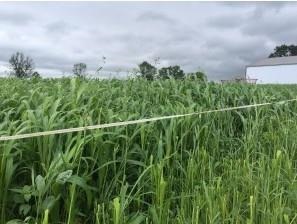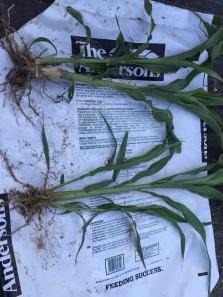
Strip grazing allows best utilization of the forage
From here I would like to describe how I utilize this outstanding summer forage option. Most grazers are advised to have a sacrifice lot to bring cows in on when extreme weather conditions could damage our forage stands. Grazing either extremely wet or extremely dry pastures can cause long term damage to our pasture. For me it is a 5 acre pasture adjacent to handling facilities and winter feed pads.
Establishment: When soil temperatures reach 60 degrees seed is planted with a notill drill at a rate of 35 pounds per acre, 1 inch depth. Under favorable growing conditions, apply 1-1.25 lbs of nitrogen per day of planned growth. For example, for a planned 60- day harvest, apply 50-75 lbs. of nitrogen.
Grass is usually grazed 45 to 55 days after emergence. For best quality and yield under multiple-grazing, harvest at 40 days or 40″ of growth, which ever comes first.
Protein will decline as harvest is delayed. Energy will increase upon heading due to continued sugar formation in the stalks and leaves and carbohydrate deposition in the developing grain.
Careful attention should be paid to the grazing height. To allow for rapid re-growth, leaving 2 nodes or 6″ is optimal. You will see increased tillering of plants thus thickening up the stand for subsequent grazing. A note of caution. These plants can accumulate a chemical called Prussic acid following large nitrogen fertilizer applications followed by drought and following a killing frost. Grazing should be delayed at minimum 7 days following a killing freeze later in the fall.

Maintaining proper grazing height encourages tillering
The biggest and most important question you should ask me is What does it cost?
Seed: $30/acre
Fertilizer at seeding (includes 50 units of N): $50/acre
Planting cost: $10/acre
I turned 56 mature bred fall calving cows into 5 acres on July 18th, forty-one days after planting. Cows grazed for three days. At 168 grazing days (56×3) and $90 per acre it comes to roughly 53 cents per cow per day.
An additional 50 units of N was applied after the first grazing. The cows were grazed an additional 5 days during the second half of August. Regrowth was amazing during those hot days last summer, and as you can see from the accompanying pictures the grass had tillered out and grown to about 16-18 inches, 15 days post grazing. And, with only fertilizer costs for the second grazing needing to be considered, the cost for those additional 5 days of grazing came to less than 20 cents per cow per day. Unfortunately, near drought conditions in Pickaway County last fall prevented the opportunity for any additional grazing.
So if you’re facing feeding winter feed stocks of hay during the summer slump or letting them “Pick” your drought stressed pastures, may I suggest you consider putting summer annuals in your lineup. They are a home run!
Source: osu.edu